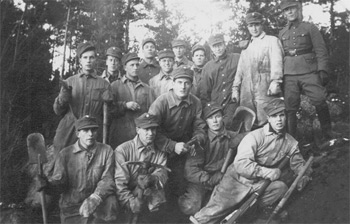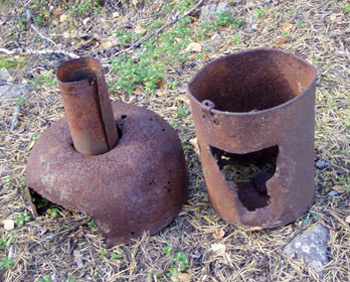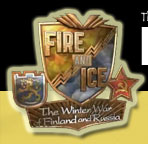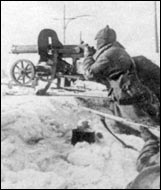

The Winter War between Finland and the Soviet Union was fought in a very vast geographic area from Karelian Isthmus in the south to the Arctic Ocean in the north. Climate conditions, the number of troops engaged in battles, terrain, the supply situation and intensity of battles varied greatly from one battlefield to another. However, it is possible to tell a story that would describe a day in a life of a Finnish and Soviet soldier at the fronts of the Winter War.

Finnish
battle engineers on the Karelian Isthmus on the first day of the
Winter War. The text on the back of the picture
reads: "Nov 30, 1939. On the first day of the war of Finland and
Russia we are on the shore of the Gulf of Finland. Good timing of
finishing
our training course."
Bair Irincheev Collection
Finnish Army reservists were called into service as early as October 1939, when negotiations in Moscow were still underway and there was hope for peace. They were called for so called extraordinary maneuvers, which were, in fact, large-scale training combined with concealed mobilization.
A Finnish reservist would come to the army in his civilian clothes, and in some cases the army did not have enough uniforms – so the reservists received only a Finnish white-and-blue hat emblem and a metal belt buckle with a Finnish lion on it. A Finnish reservist belonging to the Home Guard would come to the army assembly point in his own Home Guard uniforms and sometimes with his own weapon.
After the assembly and formation of units, reservists were transported to the main defensive lines of the Finnish Army. There Finnish soldiers manned concrete bunkers from the 1920s and 1930s and started preparations for war. In many sectors there were no fortifications at all, so Finnish soldiers were first accommodated in tents. Construction of wooden underground dugouts started immediately, and by outbreak of the war a Finnish soldier often had a heated and relatively safe accommodation underground. In northern areas of Finland, where the Finnish leadership did not expect a Soviet attack, defensive preparations remained limited and in some places Finnish soldiers had to live in tents that were heated by a stove.
During the first phases of the war the regular activity of Finnish soldiers at the main defensive line was upgrading their fortifications and sending patrols. When the Red Army approached the Finnish defenses, the situation changed radically. During the first Soviet offensive Finnish soldiers had to spend days repelling attacks of the technologically superior opponent. During the nights they had to repair damaged fortifications and obstacles. With the end of the first Soviet offensive, some Finnish sectors remained under daily heavy artillery fire. Soldiers sat in the bunkers, nervously waiting for a bunker to be hit. Nights were spent repairing collapsed trenches, bunkers and obstacle lines. Soldiers also had to take turns in trenches to make sure the Red Army infantry would not approach their positions unnoticed. Every night a patrol was sent to determine the positions of opposing Red Army units and their strength.
Food arrived at the front only when it was dark. During the day every movement on the Finnish side immediately drew fire from Red Army artillery and Red Army air force, which was patrolling over the Finnish lines. As one Finnish veteran recalled, during the day all movement ceased at the Finnish positions, but during the night the frontline was as lively as a market square. Ammo and food were brought from the rear, wounded were transported to the rear, battle engineers were repairing trenches, bunkers and obstacle lines and infantrymen had to assist them and patrols were sent to the Soviet lines.
The permanent harassment from Red Army artillery; the cold, heavy physical work; and thepsychological pressure of being in constant danger resulted in buildup of extreme fatigue among Finnish frontline soldiers. One Finnish regimental commander reported to his superiors that his men were so exhausted that they would not wake up even if the Soviet tanks were driving over their trenches.
Because of this, Finnish units on the Karelian Isthmus were rotated. Even during rest from frontline duty Finnish soldiers continued to work on building fortifications, strengthening the second line of Finnish defenses.
During the second phase of the war, when Finnish defenses were broken and the Red Army pressed towards Vyborg, the situation worsened significantly. Soldiers were constantly engaged in heavy fighting, without warm accommodation or rest. Soldiers suffered a constant lack of sleep; in some cases they froze to death when falling asleep in snow. The armistice of March 13 came when Finnish soldiers were completely exhausted and could not fight with the same efficiency as in the beginning of the war. Finland had no more men to send to the front.
Life for Red Army men at the front was even harder. The first units that marched into Finland on November 30, 1939, did not expect a proper campaign and were issued the lightest version of winter uniforms. Many Red Army divisions had just been through a Polish campaign and expected no opposition from the Finns. Stubborn resistance of the Finnish Army and high losses in the first assaults on the Mannerheim Line came as a shocking surprise. Some units took such heavy casualties that they were withdrawn from the frontline for rest and replacements.

Improvized
stoves that Red Army men made from buckets and other items that
they could find. Finger Hill, Sept 2003.
Bair Irincheev Collection
When the Red Army’s December 1939 offensive failed, its men had to settle down in the forests in front of the Finnish defenses with no accommodation available – most of the Finnish villages had been burnt by retreating Finnish Army. Inadequate uniforms resulted in losses from frostbite. In order to protect themselves from Finnish mortar and artillery fire, Red Army men dug holes and set their tents in the holes. They had to build improvised stoves in order to heat their tents and dugouts. The most common building materials were bricks from ruined buildings, empty tin ammo boxes filled with dirt, buckets, and large fuel barrels.
Real winter uniforms, factory-made dugout stoves, armored shields and other specialized equipment for winter warfare started arriving at the front in late December – early January. During this period the Red Army spent days in battle training and patrols.
The supply situation was excellent on the Karelian isthmus – Leningrad, the main supply base of the Northwestern Front, was just 60 miles from the frontline. In the north, where distances were larger and many Red Army units were surrounded, the, supply situation was catastrophic and hunger was common among Red Army men.
The text on badge of Russian Winter War veterans says: “105 hard days”. Every day of this war was full of hardships, suffering and danger for all men at the front. For more than 25,000 Finns and more than 200,000 Red Army men, one of these 105 days became the last day of their life.





